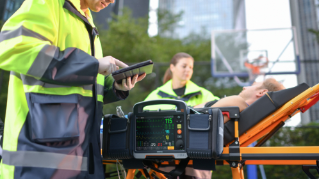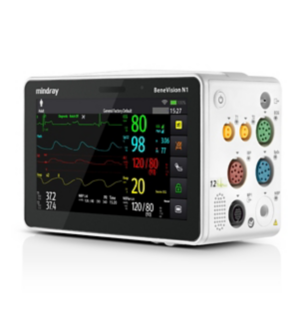Landing, collecting luggage, re-checking in, boarding,you have just been through a flight transfer, and the hassle of connecting flights can be mind-numbing. Nevertheless, it doesn't have to be - for those with an interline ticket in hand, re-board is the only process.

Like an inter-airline journey, the patient transfer within and outside the hospital is accompanied by a complex preparation. From out-of-hospital to in-hospital, from the emergency department to the operating theatre, from the critical care unit to the radiology department, doctors face the inconvenience of changing monitoring equipment and the risk of disruption to patient data during each transfer.
The "through check-in "service has reshaped the passenger's transfer experience at the airport, allowing a smooth and efficient transition. At Mindray, we are also dedicated to optimizing the patient transfer journey and providing clinicians with seamless workflow through uninterrupted patient monitoring. We have redefined the medical transfer scenario for the utmost patient safety.
Less Effort on Indicators Collecting, More Focus on Emergency Care
Before arriving at the airport, many people will check-in online to save time. For medical emergencies, time is more precious. In-hospital emergency personnel prepared in advance to save an incoming patient will undoubtedly maximize the efficiency of emergency care, freeing up more time for subsequent clinical diagnosis and treatment.
In addition to the reliability, portability, and territoriality of the transfer patient monitor, we also focus on how to synchronize all the patient indicators and trends generated during the transfer so that the in-hospital emergency personnel can make the most of the waiting time and design a treatment plan for the patient in advance.

With the BeneVision N1, a groundbreaking transport patient monitor, we offer an integrated transport monitoring solution. N1 can monitor a patient constantly throughout the journey - whether at the accident sites, in an ambulance, or a helicopter. What is more, involved in a network, N1 can share vital information remotely in real-time and synchronize data to an in-hospital monitoring system, helping emergency personnel to obtain patient data as soon as possible and prepare for treatment before the patient arrives at the hospital, thus buying time for life.
Plug and Play, Enjoy a Seamless Workflow
Of course, it is not enough to solve the connectivity between in-hospital and out-of-hospital patient data monitoring. There is still a blank space when switching between multiple monitoring devices. By breaking down the information barriers between devices, we hope further to enhance medical treatment's synergy in multiple scenarios.
Patients often undergo transfers between multiple departments during the perioperative period: pre-operative induction room - operating room - post-operative resuscitation room - intensive care unit/general ward. As in transferring passengers' luggage back and forth between flights, clinicians face the troubles of frequently changing monitors and managing cables during the patient transfer journeys. It is time-consuming and can cause inconsistencies in patient monitoring.
For in-hospital transfer, the modular design allows N1 to become a parameter module. All clinicians need to do is insert N1 into the slot of Mindray's high-acuity monitors. The hot-plugging design makes it seamless for plug-and-play. The total transfer monitoring solution automatically synchronizes the patient's identity, uploads information recorded during the transfer process, and integrates patient data. As a result, clinicians can make a quick assessment and proper treatment, realizing seamless monitoring and efficient transfers.

Smart Solutions for Flexible Choices
Patients in ICU mostly have cardiopulmonary, hepatic, and renal organ insufficiency or failure, and their vital signs may change at any time, with body fluids changing rapidly in about 90% of critically ill patients. Gastrointestinal hemorrhage, severe endocrine and metabolic disorders, disturbances in water-electrolyte and acid-base balance, liver, and kidney dysfunction are all common abnormalities in the ICU reflected in changes in body fluids.

When a patient is transferred to a general ward, the advanced parameters recorded during surgery or in the ICU are automatically stored on the N1 and uploaded to the bedside monitor, allowing healthcare professionals to easily review trends and alarm events on the N1 or bedside monitor, thus ensuring continuity of monitoring and further safeguarding patient safety.



ER


OR


ICU


CT Room
/ X-ray Room



GW

BeneVision CMS

Based on a deep understanding of patient transfer scenarios, Mindray's transfer monitoring solution reshapes the transfer scenarios by a higher-level of connectivity and accessibility. We have created a compact monitoring device and a journey without borders, linking the seamless workflow from out-of-hospital - emergency - operating theatre - ICU with flexible and rich configurations and solutions that break the boundaries of care areas and ensure patient safety.



